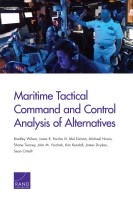| 来源类型 | Research Reports
|
| 规范类型 | 报告
|
| DOI | https://doi.org/10.7249/RR1383
|
| ISBN | 9780833095725
|
| 来源ID | RR-1383-NAVY
|
| Maritime Tactical Command and Control Analysis of Alternatives |
| Bradley Wilson; Isaac R. Porche III; Mel Eisman; Michael Nixon; Shane Tierney; John M. Yurchak; Kim Kendall; James Dryden; Sean Critelli
|
| 发表日期 | 2016
|
| 出版年 | 2016
|
| 页码 | 124
|
| 语种 | 英语
|
| 结论 |
Of the Four Alternatives, Alternative 4 Is Preferred- Alternative 1 would maintain the already-fielded GCCS-M system. This system has been found to be deficient in performance and has a high life-cycle cost compared with Alternatives 3 and 4.
- Alternative 2 builds on the status quo but does not eliminate it, thus adding capability but not rectifying other performance and cost concerns.
- Alternative 3 is focused on new developments that provide a lightweight afloat capability and a shore-based cloud. This reduces life-cycle cost but is riskier programmatically because of dependencies on other programs.
- Alternative 4 is also focused on new developments that take advantage of a shore-based cloud and an afloat cloud called the Navy Tactical Cloud. This system may be the most robust in performance and cost, yet it is risky in terms of schedule and program. Despite the risk of this alternative, the potential to improve performance and reduce life-cycle cost is too great a benefit for the Navy to ignore.
|
| 摘要 |
- The results from the performance, cost, and risk analysis are a preference for Alternative 4.
- Alternatives 3 and 4, as new systems for replacing GCCS-M, result in potential annual sustainment cost savings through fiscal year 2030.
- Information-assurance assessments acquired through in-person interviews suggest that Alternatives 3 and 4 will be relatively easier to achieve and maintain information assurance (IA) compliance than Alternatives 1 and 2, but a more-thorough IA analysis is needed.
- Maintaining the status quo supposes the least amount of risk in cost and schedule but at a monetary cost that is higher than it needs to be, given the Navy's migration to Consolidated Afloat Networks and Enterprise Services (CANES) and a performance cost whereby GCCS-M cannot meet a number of the critical performance measures identified by the Navy.
- Given this analysis, and given that the Navy is already embarking on providing shared infrastructure to support other programs that MTC2 can leverage, we recommend Alternative 4.
|
| 主题 | Military Command and Control
; Military Information Technology Systems
; Military Ships and Naval Vessels
; Modeling and Simulation
; United States Navy
|
| URL | https://www.rand.org/pubs/research_reports/RR1383.html
|
| 来源智库 | RAND Corporation (United States)
|
| 引用统计 |
|
| 资源类型 | 智库出版物
|
| 条目标识符 | http://119.78.100.153/handle/2XGU8XDN/108333
|
推荐引用方式
GB/T 7714 |
Bradley Wilson,Isaac R. Porche III,Mel Eisman,et al. Maritime Tactical Command and Control Analysis of Alternatives. 2016.
|
|
文件名:
|
x1495316311682.jpg
|
|
格式:
|
JPEG
|

|
文件名:
|
RAND_RR1383.pdf
|
|
格式:
|
Adobe PDF
|
除非特别说明,本系统中所有内容都受版权保护,并保留所有权利。